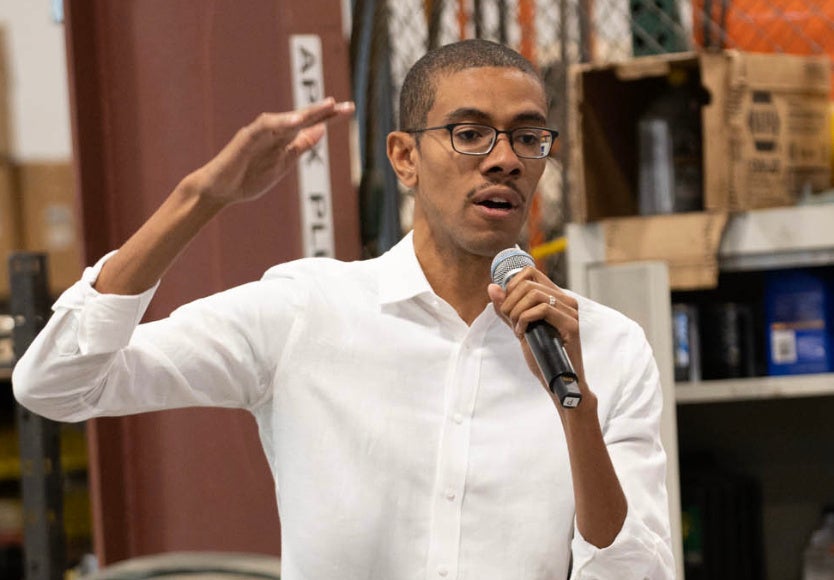Owning the Solution: Philip Reeves on How Employee Ownership Can Fight Wealth Inequality


Philip Reeves is founder and managing partner of Apis & Heritage, a private equity fund that converts closely held companies into 100% employee-owned businesses. The fund’s employee-led buyout (ELBO) approach enables workers to hold equity in the places they work, giving them one of the country’s most powerful wealth-building tools.
But A&H has a bigger mission than employee ownership; they see employee ownership as a way to fight racial wealth inequality. They seek out companies with a significant percentage of workers of color—specifically in low-wage sectors such as food processing, landscaping, healthcare, transportation, and plumbing—whose current owners want to leave a legacy of supported employees and healthy communities.
Reeves was a panelist at this year’s Employee Ownership Ideas Forum in DC, hosted by the Aspen Institute Economic Opportunities Program and the Rutgers Institute for the Study of Employee Ownership and Profit Sharing. You can watch his panel discussion here. For an insider’s view of the A&H approach, see Catalyzing Employee Ownership to Support Equity: A Conversation with Mowa Haile.
Q: What led you, personally, to the realm of employee ownership?
A: I’ve always been fascinated by entrepreneurship. I’ve studied the power of ownership in school, seen it through my extended family, and have been around entrepreneurs professionally since coming to DC. What I’ve realized is that the benefits of entrepreneurship shouldn’t just be restricted to those that had the wherewithal or capability to take a risk but should be spread more broadly—and that’s what employee ownership does. It’s a profound concept that lets everyone touch the economy as a holder of assets through something we all do—work.
Q: What is unique about A&H’s approach?
A: A&H is focused on the ESOP (employee stock ownership plan) form of employee ownership, but we add some nuance. First, we focus on service-based businesses that have diverse workforces, because we believe it’s not only a great investment model, but it’s also core to our mission of closing the racial wealth gap. Second, we have a strong focus on creating an ownership mindset throughout the organization, from the board room to the front line. One way we do that is through having employee-owners elected to the board by their peers. It clearly signals how serious we are to everyone about employees driving value. Last, we transact in a way that lets many more business owners transition their firms to their employees. We structure transactions and differ costs in a way that puts employee ownership on virtually equal footing with private equity or strategic buyers, opening the door of employee ownership to vastly more businesses.
Q: Could you give a specific example of a company that’s been through your process, and the results for the employees and their communities?
A: One of our most recent investments is a company called Blooming Nursery in Cornelius, Oregon, where we transitioned a 40-plus-year-old nursery business to the 100-plus employees. It was unique for us as it is our first rural transaction, our first time working with a women-owned business, and the first time that we’ve had a workforce with a meaningful number of female employees; in addition to being 93% workers of color, Blooming’s workforce is 22% female. Even though we just got started we’re excited to have them join the fold. Thus far (not including Blooming), we’ve impacted over 320 families and have created almost $250,000 of wealth for employees in just the first year of ownership.
Q: What are the biggest challenges facing the employee ownership movement?
A: The biggest challenges facing employee ownership is awareness. Too few people have experienced the wealth-building power of employee ownership firsthand and too few business owners are even aware it’s an option. Employee ownership isn’t mentioned in undergraduate business courses, graduate business schools, or law schools nearly to the degree that it should be. We hope that changes because of larger, mainstream employee ownership transitions like . We’ve also seen employee ownership start to get major media coverage in outlets like 60 Minutes. Hopefully as the movement gains momentum, more owners and more employees will see it as a viable option.
Q: Changing an ownership structure is one thing; changing a company culture is quite another. What are the challenges, and how does A&H address them?
A: Our view is that an ESOP alone is a great retirement benefit. To see the real value of employee ownership—lower turnover, better quality, higher productivity—a firm has to build an ownership culture. We start that process on Day One. In our very first announcement to employees, we’re trying to get across the idea that while they can’t control the share price of a major corporation on the S&P 500, they can impact the share price of their firm every day. It’s about small things like not wasting materials or staying safe, and it’s the frontline worker who has direct impact on those items day-in and day-out. Through our partnership with the Democracy at Work Institute, we have several trainings and frameworks we use to get employees bought into the idea of ownership. We establish ESOP Committees of employees to keep reinforcing the message across the organization. We also bring a new level of transparency to the businesses. Most frontline workers have no idea of the revenue or profits at their workplace, but if we’re going to have employees think of themselves as shareholders, we should treat them as such and show them financial dashboards so they can see performance. Overall, the goal of all of these efforts is to create better companies and better financial outcomes for employees.
Q: What does your job have you doing on a day-to-day basis?
A: On a day-to-day basis, I get the opportunity to work in, on, and around the great small businesses that drive this country. We’re constantly reviewing opportunities and learning about new businesses and industries, which is fascinating for me. In our own portfolio, I get the opportunity to support our management teams by bringing in resources or offering advice and connections. We’re also fortunate to have the opportunity to share this work through panels, conferences, and reports that highlight the power of employee ownership through our racial equity lens. Finally, I get to work beside the incredible A&H team, our partners, and investors in constantly iterating on our models to continue to find ways to increase our impact and deliver quality returns.
Q: What’s the most important thing you’ve learned about this kind of work?
A: The most important thing I’ve learned about this work is that everything is about people, and that in the employee ownership space everyone wants to see everyone else succeed. We were recently at one of the country’s largest employee ownership conferences and the thing that sticks out most is how collaborative the community is. Companies that have been employee-owned for a long time make it a point to share what they’ve learned with newer ESOPs. They tell stories, share templates, and give advice—all with the aim of benefiting future owners, even in spaces where firms may be competitive! The same is true of the service providers and financing groups. It’s a small community of quality practitioners who have a sense of mission behind their craft. It’s been gratifying to have some of the more established stakeholders in the space welcome A&H and our efforts.
Q: What’s one thing you wish more people knew about employee ownership?
A: I wish more people knew that this was an option for them, both as business owners and as employees. I didn’t come across employee ownership until well after entering the workforce, but have heard so many stories of employees being put on a path to wealth—blue-collar and white-collar, urban and rural across every industry imaginable. The stories of the truck driver or the machine shop operator or the baker retiring with six or even seven figures isn’t a fantasy. It’s happening. Some say it’s a “get rich slow” plan, but it could just be the answer to many of the imbalances that we see today.

Tax refunds in early 2026 could be $1,000 to $2,000 larger for many households due to retroactive tax law changes....

Why does it feel like large companies always get the upper hand? Maybe it’s the long contracts with fine print,...

What can you do if you can’t afford college? Maybe the financial aid award wasn’t enough, or you only want...